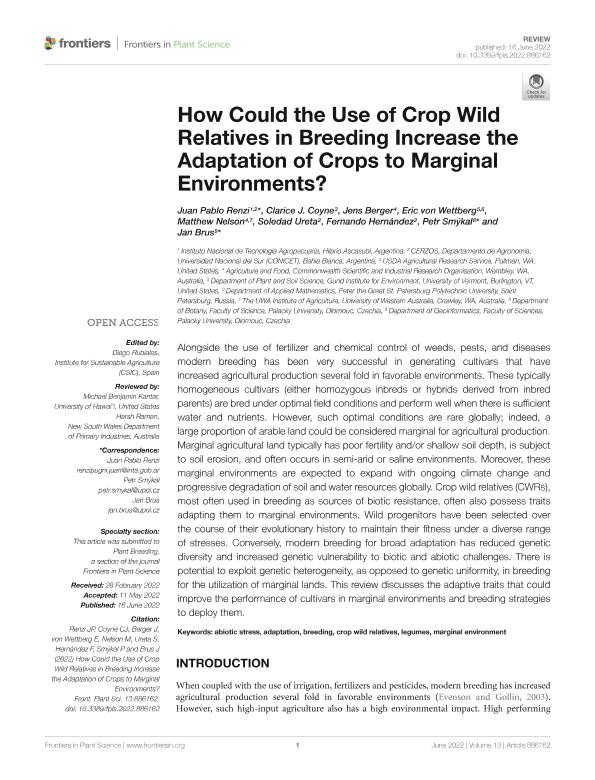Artículo
How Could the Use of Crop Wild Relatives in Breeding Increase the Adaptation of Crops to Marginal Environments?
Renzi, Juan Pablo; Coyne, Clarice J.; Berger, Jens; von Wettberg, Eric; Nelson, Matthew; Ureta, Maria Soledad ; Hernández, Fernando
; Hernández, Fernando ; Smýkal, Petr; Brus, Jan
; Smýkal, Petr; Brus, Jan
 ; Hernández, Fernando
; Hernández, Fernando ; Smýkal, Petr; Brus, Jan
; Smýkal, Petr; Brus, Jan
Fecha de publicación:
16/06/2022
Editorial:
Frontiers Media
Revista:
Frontiers in Plant Science
e-ISSN:
1664-462X
Idioma:
Inglés
Tipo de recurso:
Artículo publicado
Clasificación temática:
Resumen
Alongside the use of fertilizer and chemical control of weeds, pests, and diseases modern breeding has been very successful in generating cultivars that have increased agricultural production several fold in favorable environments. These typically homogeneous cultivars (either homozygous inbreds or hybrids derived from inbred parents) are bred under optimal field conditions and perform well when there is sufficient water and nutrients. However, such optimal conditions are rare globally; indeed, a large proportion of arable land could be considered marginal for agricultural production. Marginal agricultural land typically has poor fertility and/or shallow soil depth, is subject to soil erosion, and often occurs in semi-arid or saline environments. Moreover, these marginal environments are expected to expand with ongoing climate change and progressive degradation of soil and water resources globally. Crop wild relatives (CWRs), most often used in breeding as sources of biotic resistance, often also possess traits adapting them to marginal environments. Wild progenitors have been selected over the course of their evolutionary history to maintain their fitness under a diverse range of stresses. Conversely, modern breeding for broad adaptation has reduced genetic diversity and increased genetic vulnerability to biotic and abiotic challenges. There is potential to exploit genetic heterogeneity, as opposed to genetic uniformity, in breeding for the utilization of marginal lands. This review discusses the adaptive traits that could improve the performance of cultivars in marginal environments and breeding strategies to deploy them.
Archivos asociados
Licencia
Identificadores
Colecciones
Articulos(CERZOS)
Articulos de CENTRO REC.NAT.RENOVABLES DE ZONA SEMIARIDA(I)
Articulos de CENTRO REC.NAT.RENOVABLES DE ZONA SEMIARIDA(I)
Citación
Renzi, Juan Pablo; Coyne, Clarice J.; Berger, Jens; von Wettberg, Eric; Nelson, Matthew; et al.; How Could the Use of Crop Wild Relatives in Breeding Increase the Adaptation of Crops to Marginal Environments?; Frontiers Media; Frontiers in Plant Science; 13; 886162; 16-6-2022; 1-21
Compartir
Altmétricas



